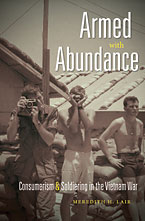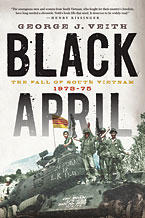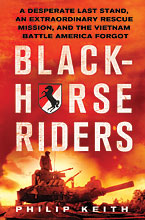 |
|||||||||
|
Books in Review, March/April 2012 Should Rear Echelon Troops Be Called “Vietnam Veterans”? REVIEWS BY MARC LEEPSON
The Pentagon officially divided units in Vietnam into three categories. Combat units “engaged the enemy directly; combat support units provided immediate support to combat troops; and combat service support units provided logistical support to ensure that enough of whatever was needed reached those on the front lines.” I gleaned that information from Meredith H. Lair, a history professor at George Mason University, in her new book, Armed With Abundance: Consumerism & Soldiering in the Vietnam War (University of North Carolina, 295 pp., $34.95), an examination and analysis of the troops who comprised the majority of those who served in the Vietnam War: us rear echelon personnel. The examination part is well done; this tome is filled with tons of facts and figures about who did what in the war based on what appears to be solid and in-depth research into official records; military newspapers, pamphlets, and guidebooks; and personal accounts of the war. The analysis part of the book, though, is deeply flawed. The main problem stems from Lair’s constant generalizing about the experiences of rear echeloners. To this reader, it appears as if she goes out of her way to emphasize the cushy aspects of some people’s tours, such as working in air conditioned offices; making regular use of swimming pools and beaches, well-stocked PXs, ice cream in the mess halls, USO and rock and roll shows on bases; not to mention taking our ease in houses of ill repute and enjoying other material comforts. The truth is that Vietnam veterans’ experiences in the war varied greatly, depending on where they served and when they were there. As fellow REMF David Willson put it after reading the book: “I would have preferred to be home in Seattle, no matter how cushy she says Long Binh Post was. I remember acres of red mud, cold showers, and lots of sandbag and shit-burning details. I never found a swimming pool or a movie theatre, let alone an air-conditioned library.” In other words, contrary to the picture Lair paints, for every clerk, cook, or truck driver who got to go to a swimming pool, gobble up ice cream, and go bowling in 1970 at Long Binh, there were thousands of support personnel who lived in tents elsewhere in country in 1965, dined on C rations in 1966, took rudimentary cold showers in 1967, and defecated into sawed-off 55-gallon drums in 1968. Lair, in fact, makes this very point early on in the book. “Individual soldiers’ experiences,” she correctly notes, “were… differentiated by time, but also by several other factors, such as where they were stationed, their branch of service, and their military occupational specialty, further complicating efforts to understand what it was like to serve in Vietnam.” In addition to grossly generalizing aspects of REMF duty, Lair also strongly implies that rear echelon personnel should think twice before calling themselves Vietnam veterans. “Support personnel,” she says, “always had to wonder about their place in the war, about the meaning of their service. And yet, upon returning home, a transformation took place, one that solidified combat as the dominant public memory of what was an often banal war. The REMFs became grunts, in the collective imagination at least, as both groups merged into one undifferentiated mass: Vietnam veterans.” I don’t recall always wondering about my place in the war during my one year in Vietnam. What I was always doing (along with everyone else in the 527th) was wondering if I would survive in one piece and get to go home. It may surprise Lair to know that there are plenty of people with clerical and other support-troop MOSs whose names are listed on The Wall. And they didn’t die after keeling over in front of their typewriters. I would like for her to know about Stephen Allison Allsopp, a clerk in the 527th who was blown up on May 6, 1968, by a Viet Cong sapper while on guard duty. Allsopp’s MOS was 74C20, Data Analysis Specialist. Of course, clerks weren’t in combat and we didn’t put our lives directly on the line against VC and NVA fighters as our brothers in the infantry did. But to imply that there is something amiss about those who weren’t in combat “merging into one undifferentiated mass” of Vietnam veterans demeans the service of the majority of men and women who served in Vietnam. We may have put in tours in the rear, but we rear echeloners went to the war zone ready to give life and limb for our country. To suggest that support personnel are not worthy of being known as Vietnam veterans is another way of dividing those who served in the war into meaningless categories with supposedly varying degrees of honor and prestige. There are other problems with the book. For one thing, it contains too much obtuse academic language and ivory-tower pedantry. In one particularly egregious example, Lair claims that an “American soldier’s desire to prove his masculinity may have been more acute in the Vietnam War” because “traditional patriarchy, in particular white male authority, was under assault at home.” Lair goes on to offer this sweeping generalization, which cannot possibly have applied to every Vietnam veteran, and, I believe, actually applied to very, very few: “Raw American recruits psyching themselves up for deployment expected an opportunity to fulfill their county’s masculine ideals against a feminized Asian other and to claim the privilege of manhood they felt their history and culture had promised them.” I could go on. But I’ll end with a giant omission. Lair all but ignores the health effects of exposure to Agent Orange among support troops. Every one of us, the Pentagon and the VA now acknowledge, was exposed repeatedly to the toxic herbicide through the water supply. We drank the contaminated water, that is, and we showered in it. Lair pays lip service to Agent Orange-related illness and to post-traumatic stress disorder. But then she says: “But more often, [Vietnam veterans’] traumas consisted of the loneliness and isolation of military life, stressors which were mitigated by the Nam’s boisterous atmosphere and somatic gratification.” I had to look up “somatic,” too. It means “of or relating to, or affecting the body.” I doubt that a former U.S. Army clerk I know who is battling Agent-Orange-caused multiple myeloma (bone cancer) would characterize his life then or now as one replete with “somatic gratification.”
Veith has made a thorough study of the military actions that took place in Vietnam during this crucial two-year period. In what is projected to be the first of two volumes, Veith has combed through official American sources and has delved deeply into a mountain of material from the former North Vietnam. That includes unit histories, battle studies, and memoirs that he had translated into English. He also mined primary source material from the former South Vietnam, including many postwar journals written by one-time South Vietnamese military men. And he conducted dozens of interviews. While the book concentrates on descriptions of what happened on the ground in Vietnam, Veith also includes his views on the politics of the war in its last stages. He subscribes to the school of thought that the primary blame for South Vietnam’s defeat lay in this country. The South Vietnamese, Veith concludes, “were far from the incompetent bunglers so often depicted. Many of them demonstrated incredible courage, even in hopeless situations…. By 1973, the South Vietnamese military, despite numerous internal and economic issues, had developed into a fighting force quite capable of defeating the North Vietnamese. If adequately supplied, and with steady American cease-fire support, the outcome of the war might have been vastly different.” Why didn’t this adequate American support come to pass? According to Veith it’s because of the U.S. Congress’s post-1973 “restraints on aid” to South Vietnam, something that came about because of agitation from “antiwar crusaders,” “major media institutions,” and the “Left around the world.” Veith also puts part of the blame on North Vietnamese perfidy after signing the Paris Peace Accords and on South Vietnamese Premier Nguyen Van Thieu’s “military blunders.”
Keith, a one-time U.S. Navy aviator in Vietnam, tells the story of Alpha troop’s dangerous and successful mission quite well. He also tells how the unit fought for years to be recognized for what took place that March 26. That effort came to fruition on October 20, 2009, when 119 men of Alpha troop came to Washington, D.C., where they received the Presidential Unit Citation in the White House’s Rose Garden.
|
|||||||||
|
|
|||||||||
8719 Colesville Road, Suite 100, Silver Spring. MD 20910 | www.vva.org | contact us |
|||||||||










